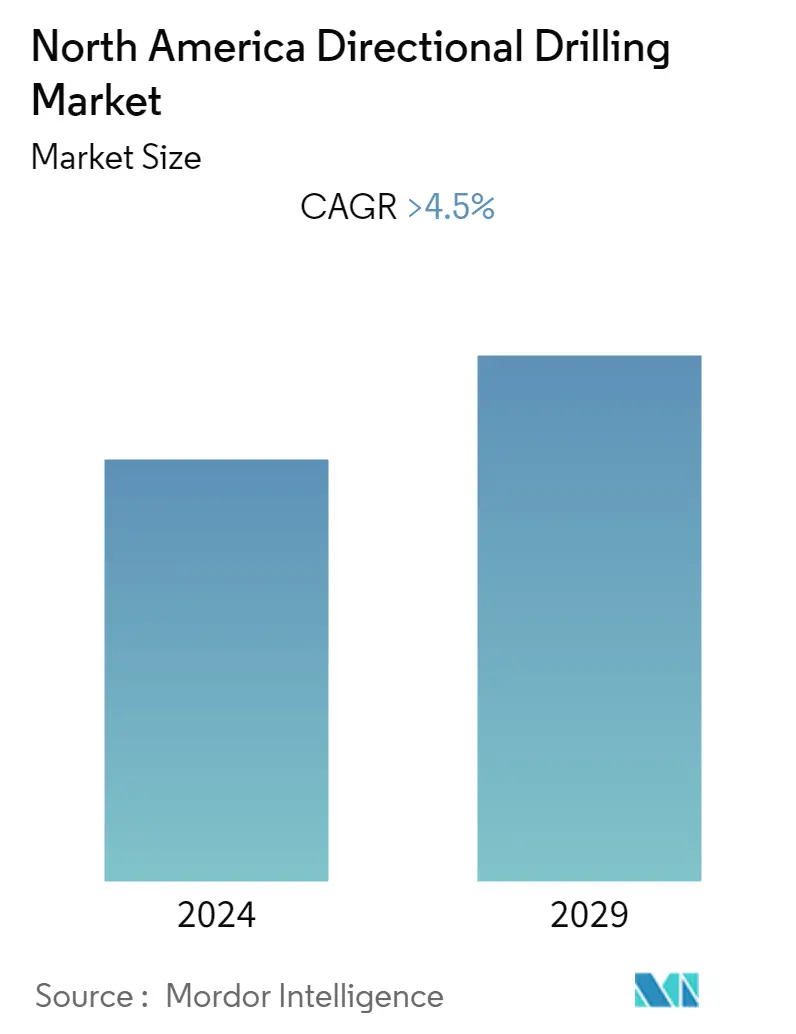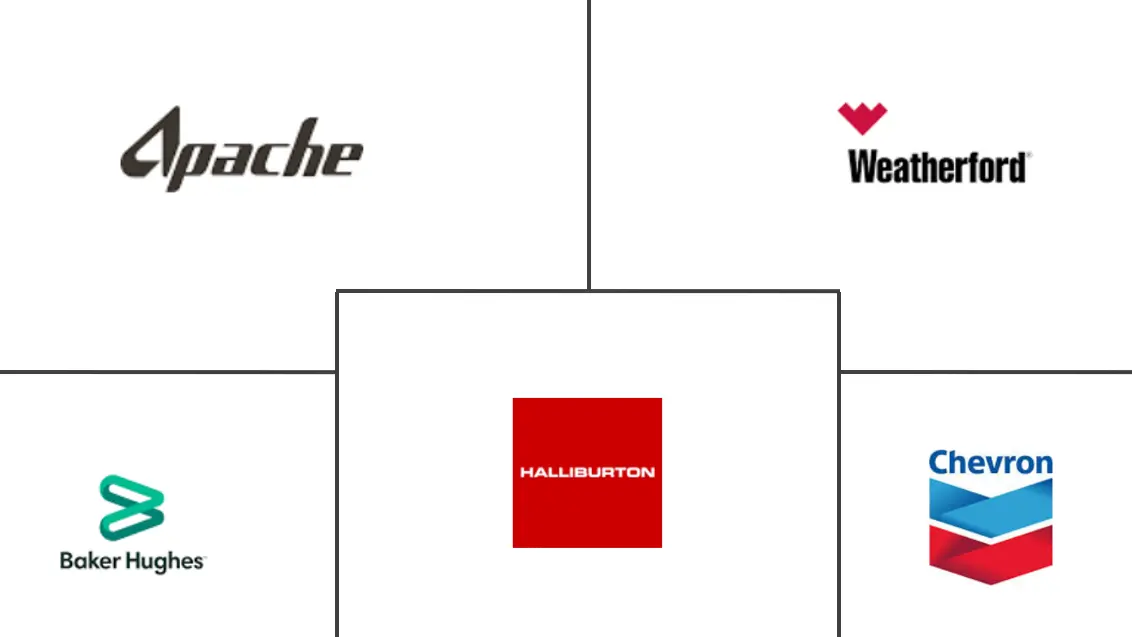Market Size of North America Directional Drilling Industry

| Study Period | 2020 - 2029 |
| Base Year For Estimation | 2023 |
| Forecast Data Period | 2024 - 2029 |
| Historical Data Period | 2020 - 2022 |
| CAGR | > 4.50 % |
| Market Concentration | Medium |
Major Players
*Disclaimer: Major Players sorted in no particular order |
North America Directional Drilling Market Analysis
The North America Directional drilling market is projected to register a CAGR of over 4.5% during the forecast period (2022-2027).
The market was negatively impacted by COVID-19 in 2020. Presently the market has now reached pre-pandemic levels.
- Over the long term, drilling in unconventional reserves, which involves directional or horizontal type drilling to increase contact with the pay zone along with increased production, is expected to drive the growth of the market studied.
- On the other hand, high volatility of crude oil prices and low-price scenarios is expected to restrain the growth of the Directional drilling maWith technological
- Nevertheless, with technological improvements and increasing viability of deepwater and ultra-deepwater projects, several new markets, such as the Gulf of Mexico actively promoting the development of deepwater and ultra-deepwater reserves are likely to provide an excellent opportunity in the forecast period.
- United States dominates the market and is also likely to witness the highest CAGR during the forecast period. In recent years the United States has emerged as a major crude oil and natural gas producer in the world, and the country is expected to maintain this during the forecast period.
North America Directional Drilling Industry Segmentation
Directional drilling is a technique used by oil-extraction companies in order to access oil in underground reserves. Directional drilling is also called directional boring. Most oil wells are positioned above the targeted reservoir, so accessing them involves drilling vertically from the surface through to the well below. The directional drilling market is segmented by service type, location of deployment, and geography. By service type, the market is segmented into rotary steerable systems, and conventional. By location of deployment, the market is segmented into onshore, and offshore. The report also covers the market size and forecasts for the Directional drilling market across major countries. For each segment, the market sizing and forecasts have been done based on revenue (USD billion).
| Location of Deployment | |
| Onshore | |
| Offshore |
| Service Type | |
| Rotary Steerable Systems (RSS) | |
| Conventional |
| Geography | |
| United States | |
| Canada | |
| Rest of North America |
North America Directional Drilling Market Size Summary
The North America directional drilling market is experiencing a resurgence, having rebounded to pre-pandemic levels after the initial setbacks caused by COVID-19. The market is poised for growth, driven by the increasing exploration of unconventional reserves, which necessitates directional and horizontal drilling techniques to enhance production efficiency. Despite challenges such as the volatility of crude oil prices, technological advancements and the growing feasibility of deepwater and ultra-deepwater projects are expected to open new avenues for market expansion. The Gulf of Mexico, in particular, is highlighted as a promising area for development, with the United States leading the charge in crude oil and natural gas production. This dominance is supported by a robust infrastructure of rotary rigs, both onshore and offshore, which are crucial for exploratory and production activities in deeper waters.
The offshore oil and gas sector plays a significant role in North America's crude oil output, with the Gulf of Mexico being a key region. The availability of abundant resources and the potential for recovery from deepwater areas present substantial opportunities for the directional drilling market. In Canada, initiatives like Saskatchewan's Vision 2030 and Alberta's increased upstream investments are set to boost oil and gas production, while Mexico seeks to revitalize its declining production through energy reforms attracting foreign investments. The United States, with its vast shale formations, continues to lead in natural gas production, driven by advancements in horizontal drilling and hydraulic fracturing. The market is moderately fragmented, with major players like Apache Corporation, Weatherford International, Halliburton, Baker Hughes, and Chevron Corporation actively participating in the sector. Recent strategic agreements and technological innovations, such as Michels Canada's record-setting horizontal directional drilling project, further underscore the dynamic nature of the market.
North America Directional Drilling Market Size - Table of Contents
-
1. MARKET OVERVIEW
-
1.1 Introduction
-
1.2 Market Size and Demand Forecast in USD billion, till 2027
-
1.3 Recent Trends and Developments
-
1.4 Government Policies and Regulations
-
1.5 Market Dynamics
-
1.5.1 Drivers
-
1.5.2 Restraints
-
-
1.6 Supply Chain Analysis
-
1.7 Porter's Five Force Analysis
-
1.7.1 Bargaining Power of Suppliers
-
1.7.2 Bargaining Power of Consumers
-
1.7.3 Threat of New Entrants
-
1.7.4 Threat of Substitutes Products and Services
-
1.7.5 Intensity of Competitive Rivalry
-
-
-
2. MARKET SEGMENTATION
-
2.1 Location of Deployment
-
2.1.1 Onshore
-
2.1.2 Offshore
-
-
2.2 Service Type
-
2.2.1 Rotary Steerable Systems (RSS)
-
2.2.2 Conventional
-
-
2.3 Geography
-
2.3.1 United States
-
2.3.2 Canada
-
2.3.3 Rest of North America
-
-
North America Directional Drilling Market Size FAQs
What is the current North America Directional Drilling Market size?
The North America Directional Drilling Market is projected to register a CAGR of greater than 4.5% during the forecast period (2024-2029)
Who are the key players in North America Directional Drilling Market?
Apache Corporation, Weatherford International PLC, Halliburton Company, Baker Hughes Company and Chevron Corporation are the major companies operating in the North America Directional Drilling Market.

